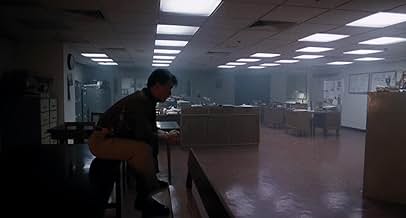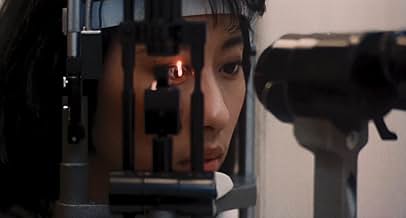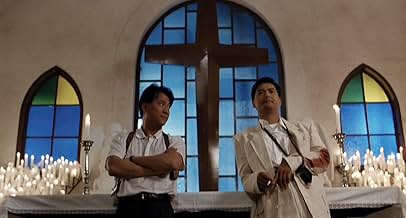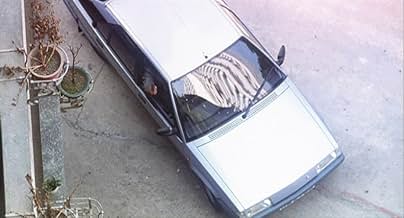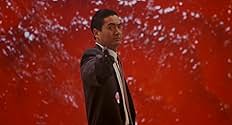IMDb-BEWERTUNG
7,7/10
52.407
IHRE BEWERTUNG
Ein Attentäter nimmt einen letzten Schlag in Kauf, in der Hoffnung, mit seinem Verdienst einem Sänger, den er versehentlich geblendet hat, das Augenlicht wiederzugeben, nur um dann von seine... Alles lesenEin Attentäter nimmt einen letzten Schlag in Kauf, in der Hoffnung, mit seinem Verdienst einem Sänger, den er versehentlich geblendet hat, das Augenlicht wiederzugeben, nur um dann von seinem Chef aufs Kreuz gelegt zu werden.Ein Attentäter nimmt einen letzten Schlag in Kauf, in der Hoffnung, mit seinem Verdienst einem Sänger, den er versehentlich geblendet hat, das Augenlicht wiederzugeben, nur um dann von seinem Chef aufs Kreuz gelegt zu werden.
- Auszeichnungen
- 2 Gewinne & 6 Nominierungen insgesamt
Chow Yun-Fat
- Ah Jong
- (as Chow Yun Fat)
Kenneth Tsang
- Sgt. Tsang Yeh
- (as Tsang Kong)
Fui-On Shing
- Wong Hoi
- (as Shing Fui On)
Ricky Wong Chun-Tong
- Paul Yau
- (as Fan Wei Yee)
Chuen Chiang
- Shooter at beach
- (Nicht genannt)
Chin-Hung Fan
- Shooter at beach
- (Nicht genannt)
Woon-Ling Hau
- Trash lady
- (Nicht genannt)
Handlung
WUSSTEST DU SCHON:
- WissenswertesJohn Woo dedicated this film to Martin Scorsese.
- PatzerThe road sign board pointing to the hospital says "SCARED HEART HOSPITAL".
- Alternative VersionenThe Taiwan version has a scene where it shows Jenny sitting in her dressing room while hearing the gunshots around 5 minutes into the movie.
Ausgewählte Rezension
"Heroic bloodshed" and "gun fu" were sub-genres coined by John Woo during the mid-80s, starting with A Better Tomorrow. This was a film that marked Woo as a rising artist within Hong Kong cinema of the modern age. After making a sequel to A Better Tomorrow, Woo went and directed The Killer, followed by Bullet in the Head and Hard-Boiled, these films proved his talent as a director who was able to illustrate ultra-violence, through what closely resembled ballet (a.k.a. in this sense, a dance of death). These outrageously stylised methods of film-making hastily became noted by Hollywood producers and Woo via a mistake on his behalf- decided to make his move to the place where financing was merely an accessory. Ever since this move, Woo has crafted numerous well-known works of commercial success, but critical failure (unlike his earlier pictures), including the likes of Broken Arrow, Face/Off, Mission Impossible 2 and Windtalkers. Shame, considering these lacked everything that his trademark works created, but can be expected with the restrictions Hollywood producers commonly put in place. Fortunately, his '80s legacy lives on and still has an acute influence on many mainstream directors of today.
The Killer propelled Woo's career, as well as that of Chow Yun-Fat, who took the title role of Ah Jong. Although, he plays an assassin, he is the kind who is out to get "the bad guys", and follows a strict code of honour and ethics. Compassionate, sympathetic and remorseful of the way in which he leads his life, Ah Jong begins to become more cynical of the brutality he savours. After accidentally blinding an innocent singer (who he later falls in love with) during a gunfight, Ah Jong's remorse overwhelms him to such a degree that he becomes determined to get a vital donor that could potentially save her eyesight. In order to finance this, Ah Jong settles a final hit, which soon spirals out of control. Law enforcement inevitably becomes aware of the destruction wreaking its way throughout Hong Kong because of the triads. Nonetheless, the cop on the case happens to be understanding of Ah Jong, and as both relate to each other they start to unexpectedly develop an unexpected partnership.
In 1992, Quentin Tarantino's Reservoir Dogs was released; now, it should be noted that the white suits used in The Killer admittedly inspired those now-infamous black suits. I bring this up because I wish to present one of the main techniques utilised in Woo's 1989, action classic. Such a procedure is contrasting the lashings of blood (shown during the countless fight scenes) against the calm, white clothing. Waving a white cloth, for example, is a sign of retreat, or peace and placing blood on white is an opposing confliction. Transcending everything that most action films can only dream of, The Killer combines a compulsory fusion of intelligence and entertainment. Then there is the paradox (as such) of both the cop and the killer using guns, but for differing reasons. Essentially, both are committing the same acts, through similar methods, but for different reasons. The two men have a certain confidence and an explicit willingness to seek fulfilment and justice, which enables a parable to be crafted between the two individuals.
Edited with a glaring visual stance, filmed through bright colour filters and following bare-knuckled narrative management, The Killer packs a well-placed gut-punch. Engaging the viewer through ultra-cool protagonists and beautifully choreographed fight scenes, this grand, wry take on the idealistic assumption of decency within the world of organised crime remains a work of bloodshed which holds artistic significance. Even with the overly dramatised screenplay (echoing a consistent waft of unsuited, moralistic sentimentality) and the dated '80s soundtrack, the piece is an extravagant and exciting take on a temperamental genre. Containing metaphors (the doves extinguishing the flames on a collection of candles) and the use of a church for a set-piece, the film is vastly unique for what is adrenaline-based action. Saying that, most directors would opt for endless cuts as a means of groping the viewer's attention, Woo on-the-other-hand avoids such an amateurish technique, choosing a cultivated approach. The finished result is a concoction of mind-boggling stand-offs and humanistic undertones, enabling it to become a motivating take on a seemingly predictable genre and an ode to the classic westerns (who said The Wild Bunch?). Remember, Chow Yun-Fat is for action, what John Wayne was for the western.
The Killer propelled Woo's career, as well as that of Chow Yun-Fat, who took the title role of Ah Jong. Although, he plays an assassin, he is the kind who is out to get "the bad guys", and follows a strict code of honour and ethics. Compassionate, sympathetic and remorseful of the way in which he leads his life, Ah Jong begins to become more cynical of the brutality he savours. After accidentally blinding an innocent singer (who he later falls in love with) during a gunfight, Ah Jong's remorse overwhelms him to such a degree that he becomes determined to get a vital donor that could potentially save her eyesight. In order to finance this, Ah Jong settles a final hit, which soon spirals out of control. Law enforcement inevitably becomes aware of the destruction wreaking its way throughout Hong Kong because of the triads. Nonetheless, the cop on the case happens to be understanding of Ah Jong, and as both relate to each other they start to unexpectedly develop an unexpected partnership.
In 1992, Quentin Tarantino's Reservoir Dogs was released; now, it should be noted that the white suits used in The Killer admittedly inspired those now-infamous black suits. I bring this up because I wish to present one of the main techniques utilised in Woo's 1989, action classic. Such a procedure is contrasting the lashings of blood (shown during the countless fight scenes) against the calm, white clothing. Waving a white cloth, for example, is a sign of retreat, or peace and placing blood on white is an opposing confliction. Transcending everything that most action films can only dream of, The Killer combines a compulsory fusion of intelligence and entertainment. Then there is the paradox (as such) of both the cop and the killer using guns, but for differing reasons. Essentially, both are committing the same acts, through similar methods, but for different reasons. The two men have a certain confidence and an explicit willingness to seek fulfilment and justice, which enables a parable to be crafted between the two individuals.
Edited with a glaring visual stance, filmed through bright colour filters and following bare-knuckled narrative management, The Killer packs a well-placed gut-punch. Engaging the viewer through ultra-cool protagonists and beautifully choreographed fight scenes, this grand, wry take on the idealistic assumption of decency within the world of organised crime remains a work of bloodshed which holds artistic significance. Even with the overly dramatised screenplay (echoing a consistent waft of unsuited, moralistic sentimentality) and the dated '80s soundtrack, the piece is an extravagant and exciting take on a temperamental genre. Containing metaphors (the doves extinguishing the flames on a collection of candles) and the use of a church for a set-piece, the film is vastly unique for what is adrenaline-based action. Saying that, most directors would opt for endless cuts as a means of groping the viewer's attention, Woo on-the-other-hand avoids such an amateurish technique, choosing a cultivated approach. The finished result is a concoction of mind-boggling stand-offs and humanistic undertones, enabling it to become a motivating take on a seemingly predictable genre and an ode to the classic westerns (who said The Wild Bunch?). Remember, Chow Yun-Fat is for action, what John Wayne was for the western.
- Det_McNulty
- 5. Nov. 2007
- Permalink
Top-Auswahl
Melde dich zum Bewerten an und greife auf die Watchlist für personalisierte Empfehlungen zu.
Details
Box Office
- Weltweiter Bruttoertrag
- 2.340.425 $
- Laufzeit1 Stunde 51 Minuten
- Farbe
- Seitenverhältnis
- 1.85 : 1
Zu dieser Seite beitragen
Bearbeitung vorschlagen oder fehlenden Inhalt hinzufügen



